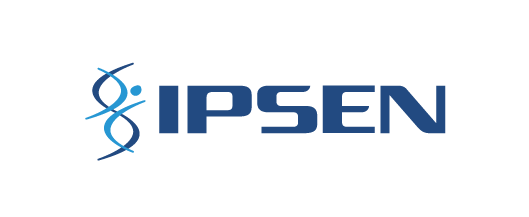Clinical research reaffirms Ipsen’s support for patients and the neuroscience community.
Paris (France), 04 July 2018 – Ipsen (Euronext: IPN; ADR: IPSEY) today announced that its neurotoxin portfolio will be the subject of 13 abstracts at the 12th International Society of Physical and Rehabilitation Medicine World Congress. The meeting will be held in Paris, July 8-12, 2018.
The 13 abstracts will present neuroscience data that advances knowledge in physical and rehabilitation medicine including clinical outcomes linked to Ipsen’s portfolio in adult spasticity (upper and lower limbs), pediatric spasticity, and in cervical dystonia. In addition, an international survey investigating the burden of spasticity on patients and their caregivers will be presented, as well as real-world data that supports better understanding of current clinical practices.
Alexandre Lebeaut, MD, Executive Vice-President, R&D, Chief Scientific Officer, Ipsen said: “Ipsen will have its strongest ever neuroscience presence at ISPRM 2018, demonstrating our strong focus on advancing the boundaries of neurotoxin research and our long-term commitment to patients and the neuroscience community, notably through medical education programs and symposia. We will also disclose new data from the first-ever recombinant botulinum neurotoxin to be administered to humans, an area where we have the ambition to advance and unlock the potential of this innovative technology platform.”Prof. Lynne Turner-Stokes, [Cicely Saunders Institute, King’s College London, UK] added: “The results of the large observational ULIS-III study, which aims to assess real-life clinical practice will be the subject of an oral presentation. This study demonstrated that pain reduction is an important and achievable primary treatment goal in some patients suffering with spasticity.”
Oral presentations:
- Abstract ISPR8-2524 – FP16 Neuro-Orthopedics and Spasticity – Part II, Amphitheatre Bleu
Wednesday 11th July 17.40 – 17.50- Botulinum Toxin A in Upper Limb Spasticity Management: Baseline Data from the Upper Limb International Spasticity (ULIS)-III Study
- Presenting author: Lynne Turner-Stokes
- Abstract ISPR8-2530 – FP16 Neuro-Orthopedics and Spasticity – Part II, Amphitheatre Bleu
Wednesday 11th July 17.50 – 18.00- Relief of Spasticity-Related Pain with Botulinum Neurotoxin-A (BoNT-A) in Real Life Practice. Post-Hoc Analysis from a Large International Cohort Series
- Presenting author: Lynne Turner-Stokes
Posters
- Abstract ISPR8-1217 – A7.02 Rehabilitation Addressing to Specific Issues – Spasticity Management, Exhibition Area, 9th–12th July
- Impact of Spasticity and Botulinum Toxin-A Injections on the Daily Life of Patients and their Caregivers: Results from an International Online Survey
- Presenting author: Manuel Murie Fernandez
- Abstract ISPR8-2146 – D3.03 Education and Training in Rehabilitation – Continuous Medical Education and Professional Development, Exhibition Area, 9th–12th July
- Botulinum Neurotoxin-A Usage and Training in Cervical Dystonia & Spastic Paresis: First Results from the Ixcellence® Network Survey
- Presenting author: Luis Jorge Jacinto
- Abstract ISPR8-2147 – D3.03 Education and Training in Rehabilitation – Continuous Medical Education and Professional Development, Exhibition Area, 9th–12th July
- Improving Management Practices of Cervical Dystonia and Spastic Paresis: 5 Years’ Experience of Ixcellence® Network, an Innovative International Educational Program
- Presenting author: Luis Jorge Jacinto
- Abstract ISPR8-2514 – 02 Rehabilitation Addressing to Specific Issues – Spasticity Management, Exhibition Area, 9th–12th July
- Simultaneous Upper and Lower Limb AbobotulinumtoxinA Injections and Guided Self-Rehabilitation Contracts in Spastic Hemiparesis: Baseline Data from the ENGAGE Study
- Presenting author: Jean-Michel Gracies
- Abstract ISPR8-2521 – A7.02 Rehabilitation Addressing to Specific Issues – Spasticity Management, Exhibition Area, 9th–12th July
- Repeated AbobotulinumtoxinA Injections Benefit Walking Speed, Step Length and Cadence in Adults with Spastic Hemiparesis due to Stroke or Traumatic Brain Injury
- Presenting author: Alberto Esquenazi
- Abstract ISPR8-2529 – A7.02 Rehabilitation Addressing to Specific Issues – Spasticity Management, Exhibition Area, 9th–12th July
- Efficacy and Safety of Early Use of AbobotulinumtoxinA in Adults with Post-Stroke Spasticity: Results from the ONTIME and ABCDE-S Studies
- Presenting author: Raymond Rosales
- Abstract ISPR8-2543 – A7.02 Rehabilitation Addressing to Specific Issues – Spasticity Management, Exhibition Area, 9th–12th July
- Treatment Frequency for Long-Term Efficacy of AbobotulinumtoxinA Injections: a Phase 3 Study in Patients with Upper Limb Spasticity Following Stroke or Traumatic Brain Injury
- Presenting author: Jean-Michel Gracies
- Abstract ISPR8-2546 – A7.02 Rehabilitation Addressing to Specific Issues – Spasticity Management, Exhibition Area, 9th–12th July
- When Can Maximal Efficacy be Expected with Repeated Botulinum Toxin Injections in Upper Limb Spastic Paresis? An Exploratory Statistical Analysis
- Presenting author: Jean-Michel Gracies
- Abstract ISPR8-2547 – A7.02 Rehabilitation Addressing to Specific Issues – Spasticity Management, Exhibition Area, 9th–12th July
- AbobotulinumtoxinA Injections in Shoulder Muscles: Results from a Real World (ULIS-II) and Phase 3 (AUL) Studies
- Presenting author: Francois Constant Boyer
- Abstract ISPR8-2557 – A7.02 Rehabilitation Addressing to Specific Issues – Spasticity Management, Exhibition Area, 9th–12th July
- Treatment Frequency for Long-Term Efficacy of AbobotulinumtoxinA Injections: a Phase 3 Study in Patients with Lower Limb Spasticity Following Stroke or Traumatic Brain Injury
- Presenting author: Prof Jean-Michel Gracies
- Abstract ISPR8-2654 – A2.08 Musculoskeletal Conditions – Miscellanous, Exhibition Area, 9th–12th July
- Results from the First Recombinant Botulinum Toxin (BoNT) Ever to Enter Clinical Development. Outcomes of a First-in-Human Study with Recombinant BoNT/E (SXN102308)
- Presenting author: Laurent Pons








